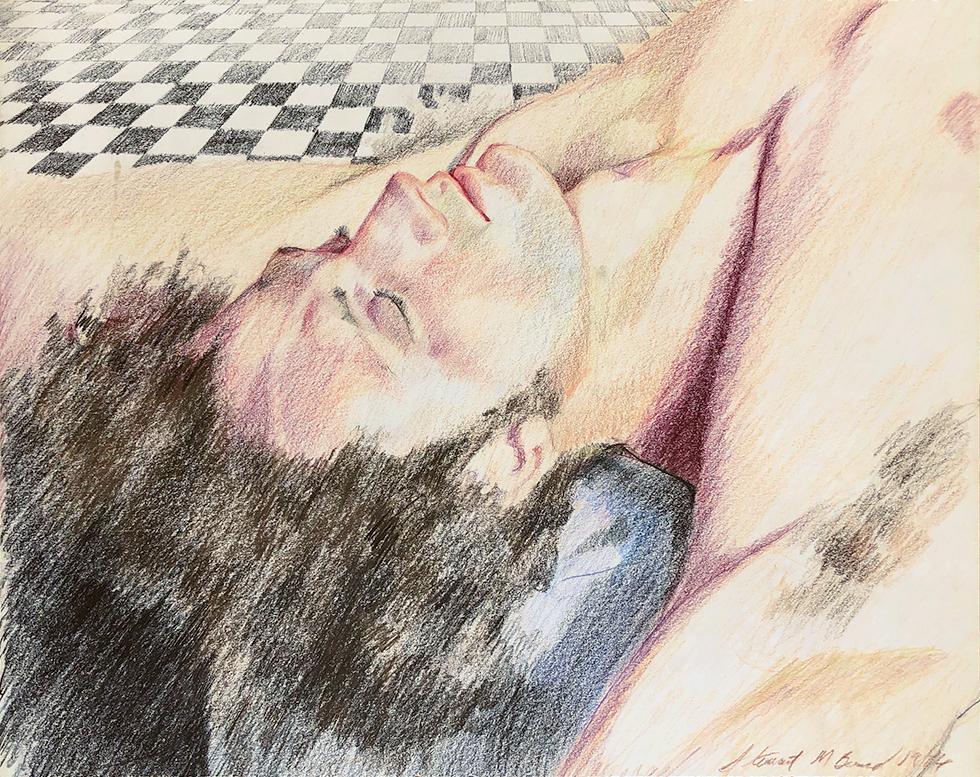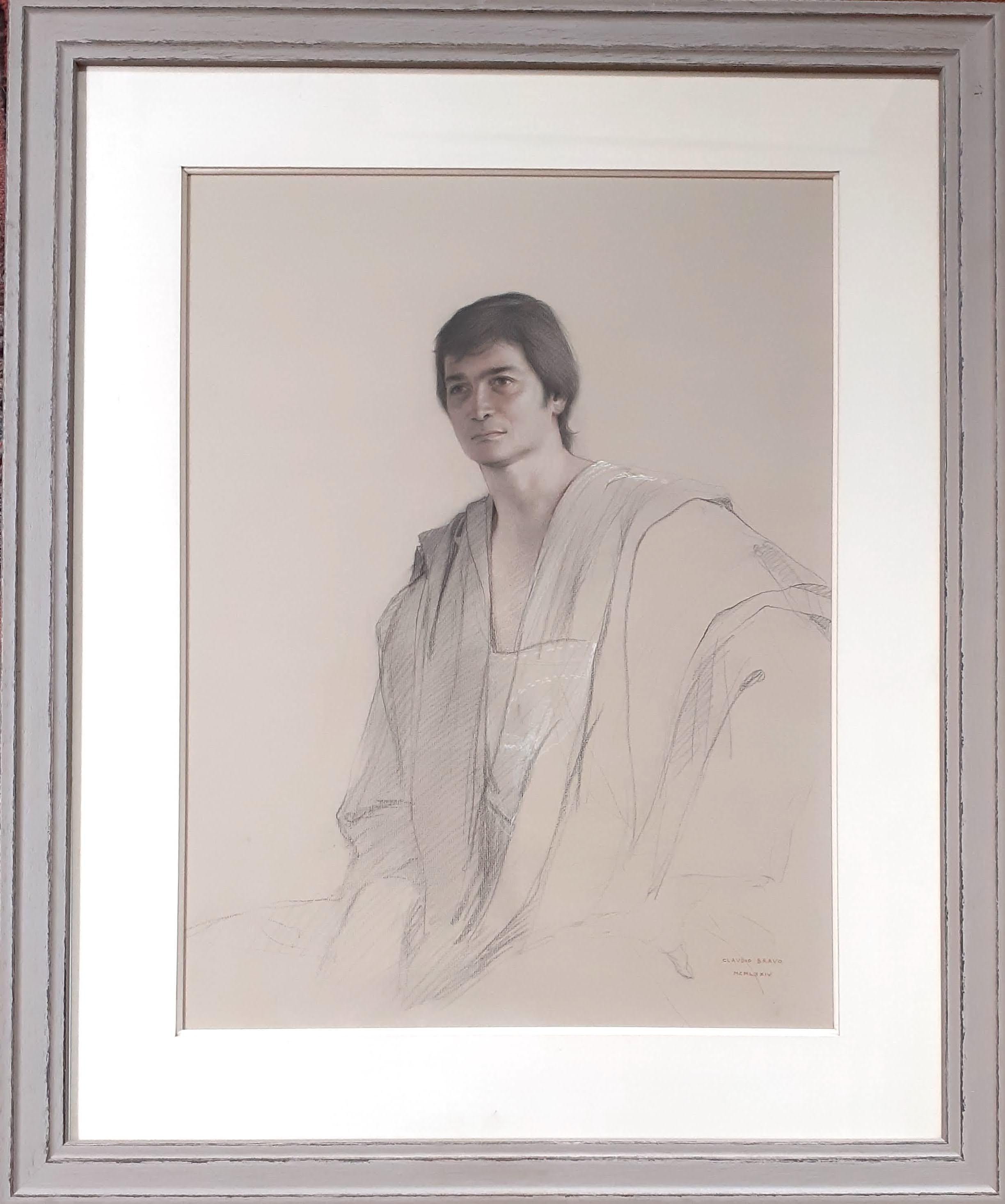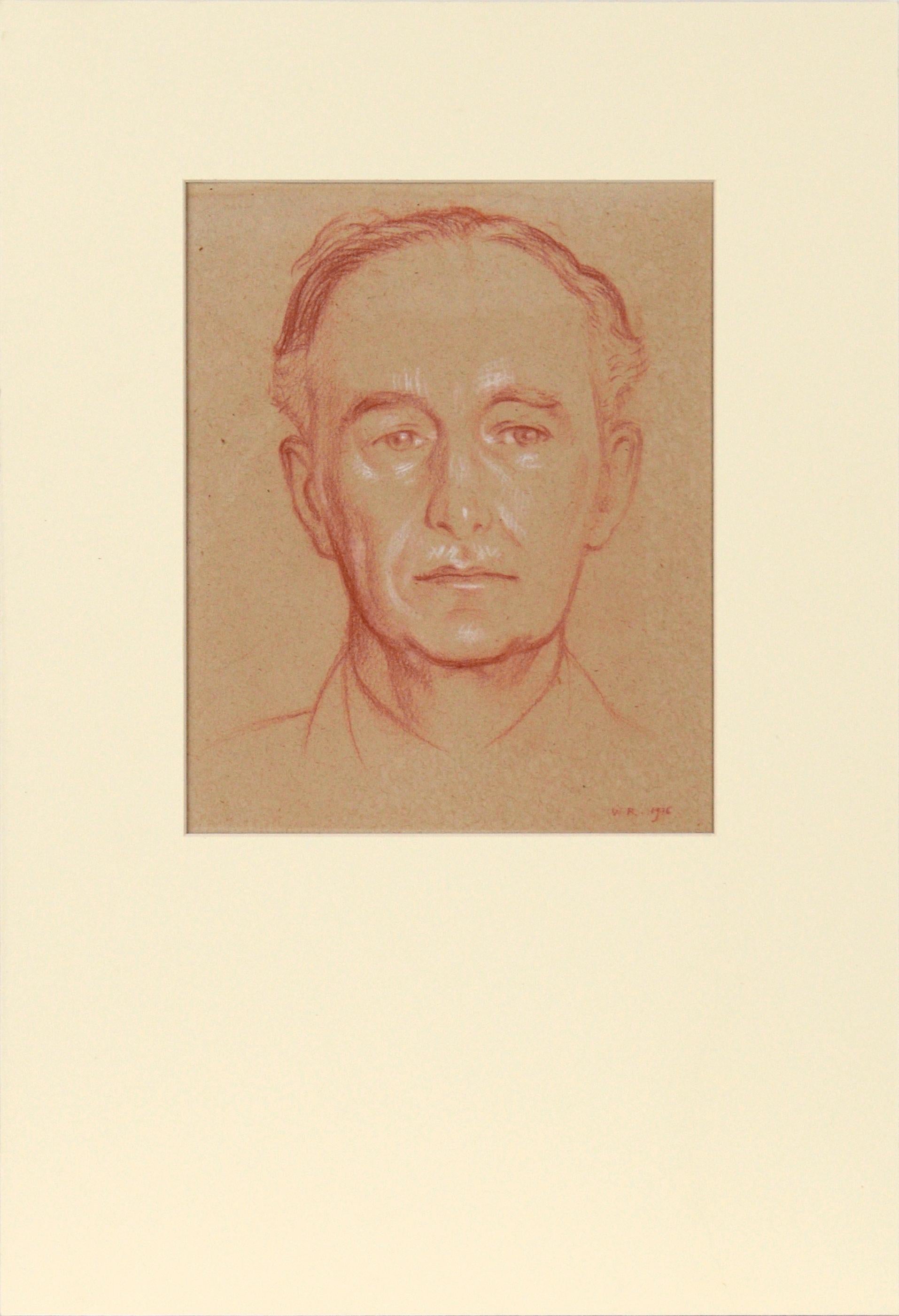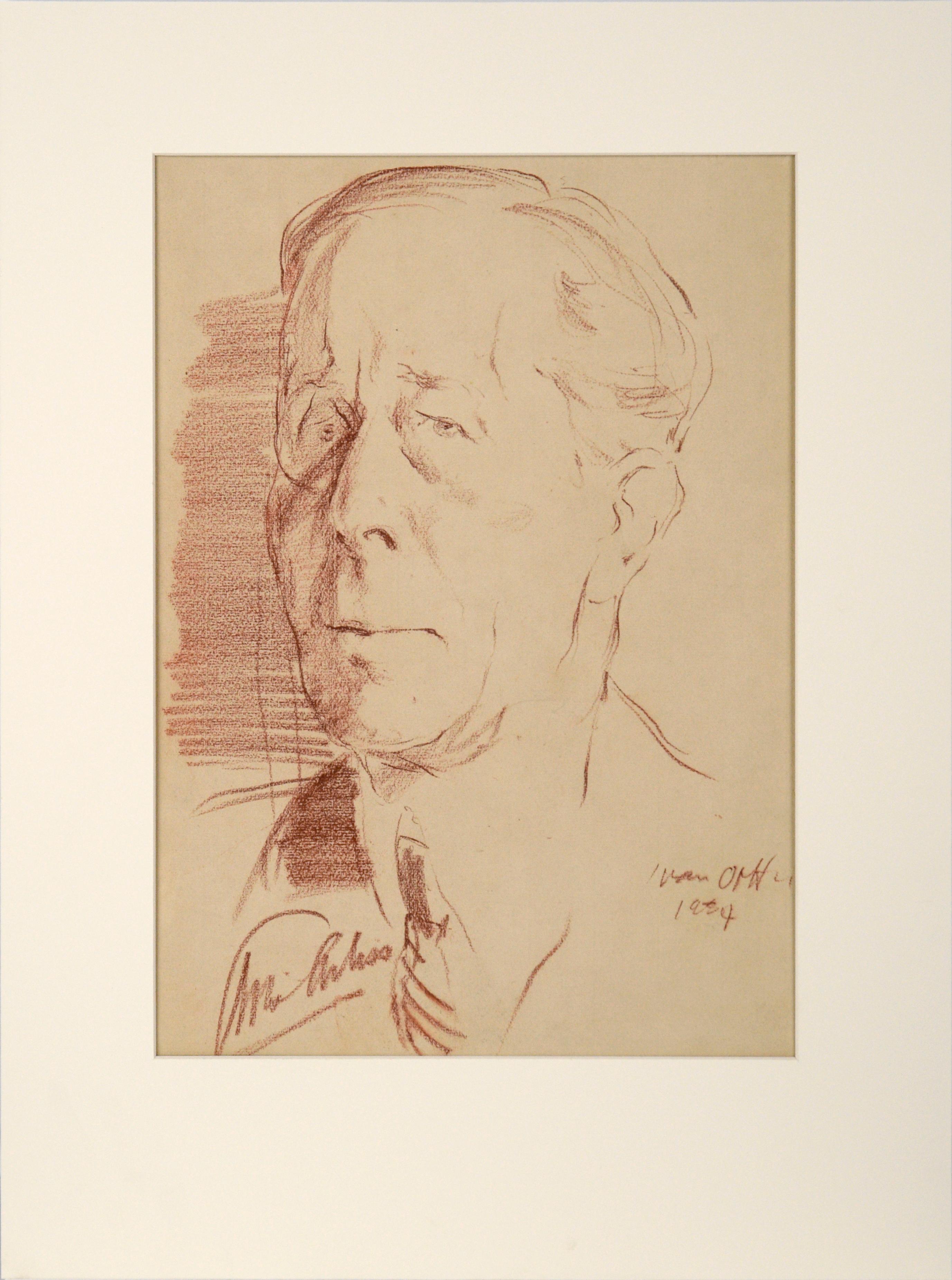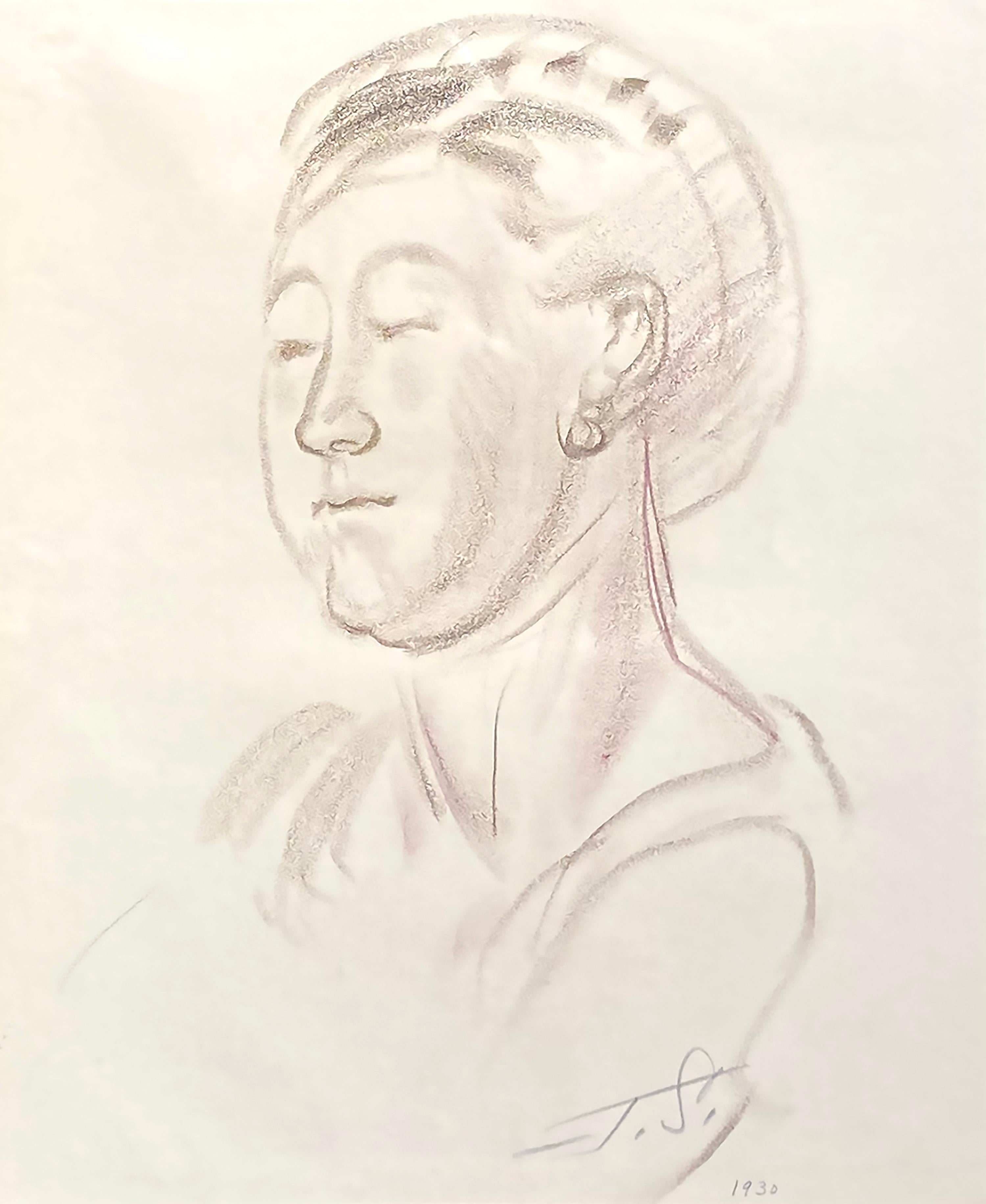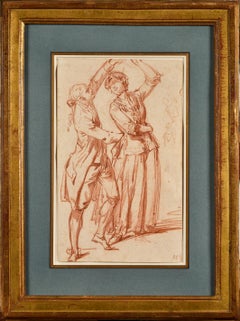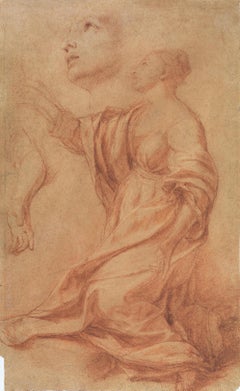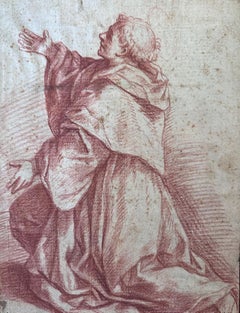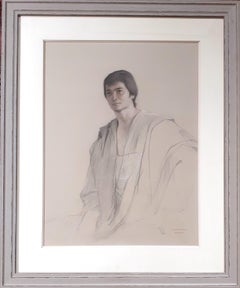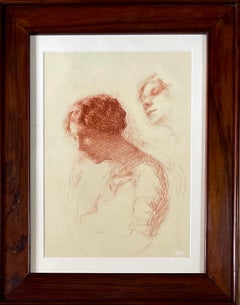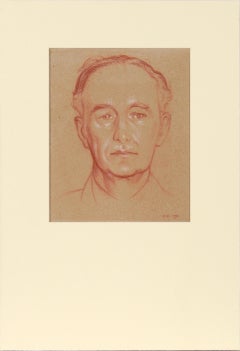Items Similar to The Loving Couple
Want more images or videos?
Request additional images or videos from the seller
1 of 5
The Loving Couple1919
1919
$2,690.20
£1,989.35
€2,250
CA$3,722.83
A$4,145.14
CHF 2,157.05
MX$50,031.10
NOK 27,051.42
SEK 25,551.77
DKK 17,133.87
About the Item
Circle of Charles Angrand (1854-1926)
The Loving Couple
Pencil and stump on paper,
30 x 22 cm
Dated "10.4.19" lower left. Trace of a dedication
Otherwise unsigned.
Provenance:
Private collection, France
This drawing, attributed to the circle of Charles Angrand, reveals a symbolist sensitivity and a pronounced taste for intimate, enveloping atmospheres. Executed in pencil and stump, the scene is immersed in a subdued, almost unreal light, where the forms dissolve into a poetic chiaroscuro. The subject—a couple, one seated in the shadows, the other standing, haloed in light—appears to belong to a world suspended between dream and reality.
Charles Angrand, a discreet yet essential figure of the Neo-Impressionist movement, was a close associate of Seurat, Signac, and Luce. His works bear witness to a constant exploration of light and tonal modulation, particularly in his charcoal and chalk drawings, often regarded as his most accomplished creations. This work, dated 1919, although produced after the apogee of Neo-Impressionism, retains its spirit in the pursuit of subtlety and suggestion.
The style here evokes the artist’s research into diffuse light, rendered through a masterful use of the stump, which lends the scene an almost mystical aura. The treatment of the paper, the softness of the modeling, and the sobriety of the composition also recall the influence of Symbolism, a movement still resonant in artistic circles of the interwar period.
The work conveys a meditative, almost funereal atmosphere, reinforced by the partial effacement of lines and the choice of a brown-ochre monochrome. The absence of sharp detail favors an emotional rather than narrative reading, leaving space for the viewer’s interpretation. The presence of a trace of dedication suggests an intimate work, possibly created for or offered to a close acquaintance.
Within the context of Angrand’s oeuvre and that of his followers, The Loving Couple illustrates with precision the importance of drawing as an autonomous means of expression, capable of conveying the subtlest emotions with remarkable economy of means.
- Creation Year:1919
- Dimensions:Height: 11.82 in (30 cm)Width: 8.67 in (22 cm)
- Medium:
- Movement & Style:
- Circle Of:Charles Angrand (1854 - 1926, French)
- Period:
- Condition:
- Gallery Location:Paris, FR
- Reference Number:1stDibs: LU2258216826462
About the Seller
No Reviews Yet
Vetted Professional Seller
Every seller passes strict standards for authenticity and reliability
Established in 2010
1stDibs seller since 2022
Typical response time: 8 hours
- ShippingRetrieving quote...Shipping from: Saint-Sylvestre, France
- Return Policy
Authenticity Guarantee
In the unlikely event there’s an issue with an item’s authenticity, contact us within 1 year for a full refund. DetailsMoney-Back Guarantee
If your item is not as described, is damaged in transit, or does not arrive, contact us within 7 days for a full refund. Details24-Hour Cancellation
You have a 24-hour grace period in which to reconsider your purchase, with no questions asked.Vetted Professional Sellers
Our world-class sellers must adhere to strict standards for service and quality, maintaining the integrity of our listings.Price-Match Guarantee
If you find that a seller listed the same item for a lower price elsewhere, we’ll match it.Trusted Global Delivery
Our best-in-class carrier network provides specialized shipping options worldwide, including custom delivery.More From This Seller
View AllDancing Couple
Located in Paris, Île-de-France
Attributed to Charles-Nicolas Cochin the Younger (Paris, 1715 – 1790)
Dancing Couple
Circa 1765–1770
Red chalk on cream paper; verso in black and red chalk
34 × 21 cm
Unsigned
Pro...
Category
Late 18th Century Old Masters Figurative Drawings and Watercolors
Materials
Chalk
Studies of a kneeling female figure, an arm, a hand, and a head in profile
By Carlo Maratta (Ancona 1625 - Rome 1713)
Located in Paris, Île-de-France
Studio of Carlo Maratti (or Maratta)
Camerano 1625 – Rome 1713
Studies of a kneeling female figure, an arm, a hand, and a head in profile
Red chalk on paper
43.4 x 26.6 cm
Unsigne...
Category
Late 17th Century Old Masters Figurative Drawings and Watercolors
Materials
Chalk
Italian School, 17th century - Study for the Vision of Saint Anthony
Located in Paris, Île-de-France
Italian School, 17th century
Study for the Vision of Saint Anthony
Red chalk on paper
247 x 185 mm
Unsigned
Provenance
Private collection, Paris
Collection of Count Alessandro Mag...
Category
17th Century Old Masters Figurative Drawings and Watercolors
Materials
Chalk
Apelles holding his palette and brushes
By Jean-Auguste-Dominique Ingres
Located in Paris, Île-de-France
Jean-Auguste-Dominique Ingres
(Montauban 1780 – Paris 1867)
Apelles holding his palette and brushes
Late reinterpretation after The Apotheosis of Homer – c. 1860
Black chalk, stump...
Category
1860s Academic Portrait Drawings and Watercolors
Materials
Laid Paper, Pencil
The Holy Family with the Infant Saint John the Baptist
By Raphael (Raffaello Sanzio da Urbino)
Located in Paris, Île-de-France
STUDIO OF RAFFAELLO SANZIO, called RAPHAEL
(Urbino 1483 – Rome 1520)
Title The Holy Family with the Infant Saint John the Baptist
Medium Pen and brown ink, brown wash, over black ch...
Category
16th Century Old Masters Figurative Drawings and Watercolors
Materials
Ink
French School, dated 1907 Portrait of a Young Girl with a White Headscarf
Located in Paris, Île-de-France
French School, dated 1907
Portrait of a Young Girl with a White Headscarf
Charcoal on laid paper with watermark "CF" in a shield with caduceus (Canson Frères)
45 × 35 cm
Signed and d...
Category
Early 20th Century Post-Impressionist Portrait Drawings and Watercolors
Materials
Chalk
You May Also Like
Untitled (Man Reclining on Tile Floor)
By Mark Beard
Located in New York, NY
Graphite and conté crayon on paper
Signed and dated, l.r.
This artwork is offered by ClampArt, located in New York City.
Mark Beard, born in 1956 in Salt Lake City, now lives in Ne...
Category
1970s Realist Figurative Drawings and Watercolors
Materials
Paper, Graphite, Conté
Young man in a toga elegant man Latin American hyperrealist Hockney style
By Claudio Bravo
Located in Norwich, GB
Superb original drawing in coloured conté pencils, heightened with white on oatmeal coloured vergé paper by Claudio Bravo. The work was created during the artist's Moroccan period, a...
Category
1970s Modern Portrait Drawings and Watercolors
Materials
Conté, Laid Paper, Color Pencil
Study of young woman in profile
By Ernest Laurent
Located in PARIS, FR
Ernest LAURENT
Gentilly 1859 - Bièvres 1929
Study of young woman in profile
Red chalk
Circa 1900
80 x 63 cm framed
54 x 39 sheet
Beautiful antique frame in natural wood, probabl...
Category
Early 20th Century Post-Impressionist Portrait Drawings and Watercolors
Materials
Chalk
Portrait of Leopold Myers by Sir William Rothenstein
By Sir William Rothenstein
Located in Soquel, CA
Stately sanguine portrait of Leopold Hamilton Myers (Novelist) by Sir William Rothenstein (English, 1872-1945). Captured in Rothenstein's characteristic style, Myers looks directly at the viewer with a neutral expression. Although this portrait uses only two colors and minimal shading, the likeness of Myers is incredibly well captured. Leo (Leopold) Hamilton Myers (1881 – 1944) was a British novelist. Numerous examples like this one of the writer are in the Tate Museum.
Initialed and dated in the lower right corner ("W.R. 1936")
Inscription on verso indicating materials, subject, and artist.
Presented in a new cream colored mat with foamcore backing.
Mat size: 18"H x 12"W
Paper size: 15.25"H x 10.75"W
William Rothenstein (English, 1872-1945) was born into a German-Jewish family in Bradford, West Yorkshire. His father, Moritz, emigrated from Germany in 1859 to work in Bradford's burgeoning textile industry. Soon afterwards he married Bertha Dux, and they had six children, of which William was the fifth. Rothenstein was knighted in 1931.
Rothenstein left Bradford Grammar School at the age of sixteen to study at the Slade School of Art*, London (1888-1893), where he was taught by Alphonse Legros, and the Académie Julian* in Paris (1889-1893), where he met and was encouraged by James McNeill Whistler, Edgar Degas and Henri Toulouse-Lautrec. Whilst in Paris he also befriended the Anglo-Australian artist Charles Conder, with whom he shared a studio in Montmartre. In 1893 he returned to England to work on "Oxford Characters" a series of lithographic* portraits.
In Oxford he met and became a close friend of the caricaturist* and parodist Max Beerbohm, who later immortalised him in the short story Enoch Soames (1919). During the 1890s Rothenstein exhibited with the New English Art Club* and, in 1900, won a silver medal for his painting The Doll's House at the Exposition Universelle. In 1898 he co-founded the Carfax Gallery in St. James' Piccadilly with John Fothergill. During its early years the gallery was closely associated with such artists as Charles Conder, Philip Wilson Steer, Charles Ricketts and Augustus John. It also exhibited the work of Auguste Rodin, whose growing reputation in England owed much to Rothenstein's friendship and missionary zeal. The gallery was later the home for all three exhibitions of The Camden Town Group*, led by Rothenstein's friend and close contemporary Walter Sickert.
Rothenstein is best known for his portrait drawings of famous individuals and for being an official war artist in both World War I and World War II. He was also a member of the International Society of Sculptors, Painters & Gravers. The style and subject of his paintings varies, though certain themes reappear, in particular an interest in 'weighty' or 'essential' subjects tackled in a restrained manner. Good examples include Parting at Morning (1891), Mother and Child (1903) and Jews Mourning at a Synagogue (1907) - all of which are owned by the Tate Gallery. The National Portrait Gallery owns over two hundred of his portraits. In 2011 the BBC and the Public Catalogue Foundation began cataloguing all of his paintings in public ownership online.
Between 1902 and 1912 Rothenstein lived in Hampstead, London, where his social circle included such names as H.G.Wells, Joseph Conrad and the artist Augustus John. Amongst the young artists to visit Rothenstein in Hampstead were Mark Gertler...
Category
1930s Realist Portrait Drawings and Watercolors
Materials
Conté, Handmade Paper
$2,112 Sale Price
35% Off
Portrait of George Arliss in Conte Crayon on Cardstock 1934
Located in Soquel, CA
Stately portrait of George Arliss by Ivan Opffer (Danish, 1897-1980). Mr. Arliss is depicted wearing his signature monocle, looking directly at the viewer. Although this piece appears to be done rapidly, there is a clear confidence in Opffer's work - he was an accomplished portrait artist - and the resemblance to the subject is unmistakable. George Arliss (born Augustus George Andrews; 10 April 1868 – 5 February 1946) was an English actor, author, playwright, and filmmaker who found success in the United States. He was the first British actor to win an Academy Award – which he won for his performance as Victorian-era British prime minister Benjamin Disraeli in Disraeli (1929) – as well as the earliest-born actor to win the honour. He specialized in successful biopics, such as Disraeli, Voltaire (1933), and Cardinal Richelieu (1935), as well as light comedies, which included The Millionaire (1931) and A Successful Calamity (1932).
Signed and dated "Ivan Opffer 1934" in the lower right.
Titled "Mr. Arliss" in the lower left.
Presented in a new off-white mat with foamcore backing.
Mat size: 22"H x 16"W
Art size: 17.5"H x 12"W
Ivan Opffer (Danish, 1897-1980) was born in Nyborg, Denmark, on June 4, 1897, to a family of Danish scholars and journalists. His brother was Emil Opffer, a Danish merchant seaman and journalist who was known for his relationship with American writer Hart Crane.
Ivan was raised in Mexico City and New York, where his anarchist father was the editor of a radical Danish-language newspaper. His involvement in painting and drawing began at an early age. At a summer workshop, he met and studied drawing with Winslow Homer, then went on to study at the National Academy of Design and the Art Students League of New York.
When the US entered World War I, Opffer was one of the members of the American Army Camouflage Corps, headed by Homer Saint-Gaudens (whose mother was a relative of Winslow Homer), the son of Augustus Saint-Gaudens. As a camoufleur, Opffer served with other artists and architects, some of whom became well-known, including Barry Faulkner, Sherry Edmundson Fry, Kimon Nicolaides, Robert Lawson, Abraham Rattner, Kerr Eby, and others.
It was this same unit, while still in training in at Camp American University in Washington DC, that launched a camp newspaper called The Camoufleur. Only three issues were published before the unit’s deployment to France in late 1917. In the October 31 issue, a satirical portrait by Opffer of Homer Saint-Gaudens (titled “Our Boss”) was published on page 5.
After the war, Opffer returned to New York, where he became known for his caricatures of leading Modern writers, among them James Joyce, Edgar Lee Masters, Siegfried Sassoon, George Bernard Shaw, Carl Sandburg, G.K. Chesterton, and Thomas Mann.
In the years between the wars, Opffer married Betty à Beckett Chomley, and settled in Paris, where he was a student at the Academie Julliard. He also lived in London and Copenhagen, where his drawings were frequently published in newspapers and magazines. With the outbreak of World War II, he and his family returned to New York and lived in Greenwich Village.
Among his friends in that era were William Butler Yeats, F. Scott and Zelda Fitzgerald...
Category
1930s American Impressionist Portrait Drawings and Watercolors
Materials
Conté, Postcard, Illustration Board
$920 Sale Price
20% Off
Head Study, 1930
By John Sloan
Located in Missouri, MO
Head Study, 1930
John Sloan (1871-1951)
Signed Lower Right
10.5" x 9" Unframed
19" x 16.5" Framed
Born in Lock Haven, Pennsylvania, John Sloan became one o...
Category
Early 20th Century Ashcan School Portrait Drawings and Watercolors
Materials
Paper, Conté
Price Upon Request
